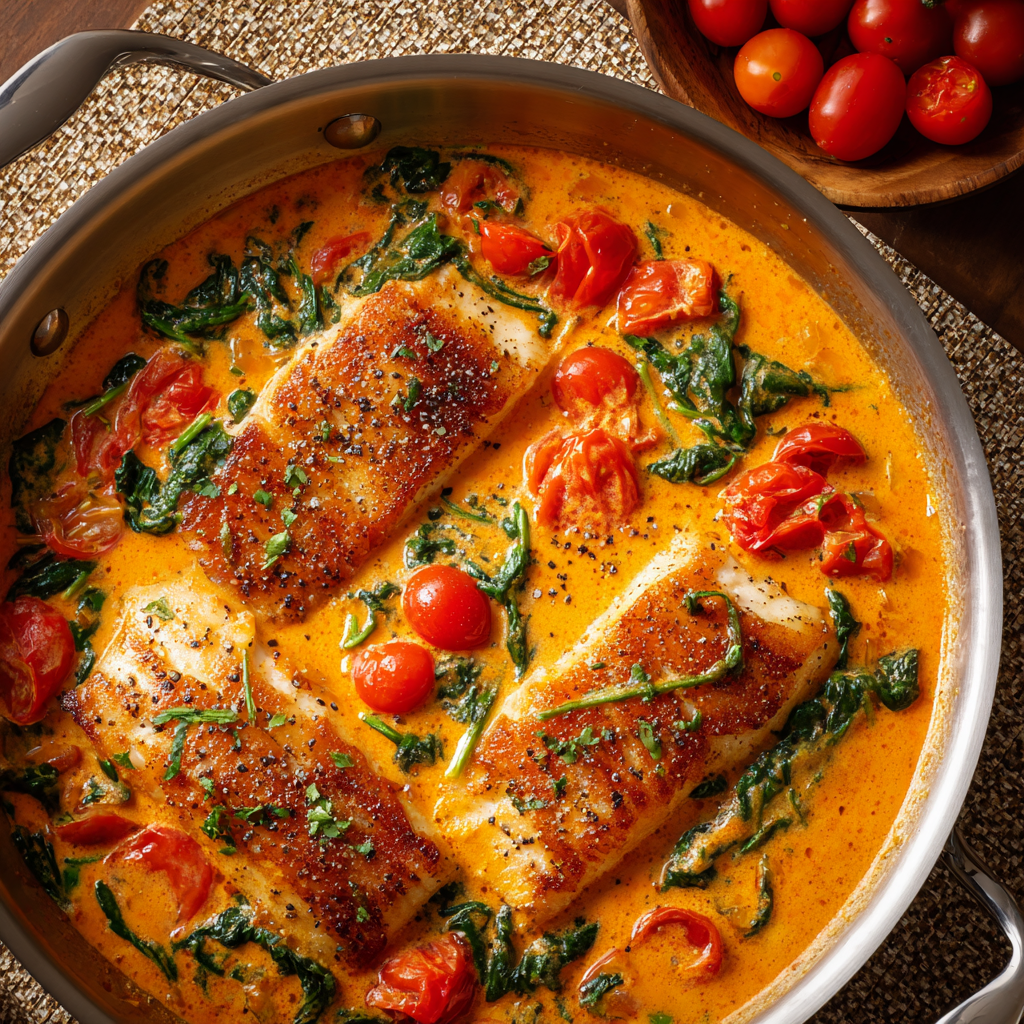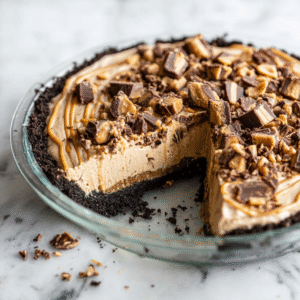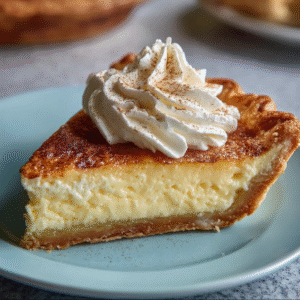Introduction
There’s something deeply satisfying about a piece of fish that crisps up golden on the outside and stays tender and flaky inside — and that magic is exactly what this Crispy Salmon with Roasted Red Pepper Sauce delivers. Imagine the crisp sear cracking delicately against your fork, releasing warm, buttery aromas of salmon oils mingling with a hint of char. Then you dip it into a vibrant, velvety sauce made from roasted red peppers — bright, smoky, slightly sweet — and suddenly each bite becomes a symphony of textures and flavors.
This dish feels both elegant and cozy at once. The salmon is crisp and luxurious, perfect for a dinner that feels special; the red pepper sauce adds warmth and richness, like a comforting hug on a cold evening. Whether you serve it for a quiet weeknight alone or as part of a relaxed dinner with loved ones, it brings warmth, color, and satisfaction in every bite.
What I love most is how this recipe celebrates contrasts: crisp vs tender, smoky vs sweet, rich vs light. It’s the kind of meal that makes you slow down — savoring the first crisp bite, then the smooth sauce gliding over the flaky fish. Once you try it, you’ll find yourself craving that comforting warmth again and again.
So preheat your skillet, roast some peppers, and get ready to bring a splash of color and comfort to your table — this Crispy Salmon with Roasted Red Pepper Sauce might just become one of your go-to favorites.
Why You’ll Love This Recipe
- Perfectly crispy outside, moist inside: salmon gets a golden crust while remaining flaky and tender.
- Sauce full of depth and warmth: roasted red peppers bring smokiness, natural sweetness, and vibrant color.
- Elegant yet simple: restaurant-quality flavors with easy-to-follow steps and minimal fuss.
- Balanced and satisfying: rich fish and silky sauce paired with light sides — never heavy.
- Visually stunning: the bright red sauce against the salmon makes for a beautiful plate.
- Flexible: easily swappable ingredients and adaptable to what you have at home.
Ingredients
For the Crispy Salmon
- 4 salmon fillets (about 6 oz / 170 g each), skin on or off, as you prefer
- Salt and freshly ground black pepper, to taste
- 2 tablespoons olive oil (or a mix of olive oil and butter)
- Optional: a squeeze of fresh lemon juice for serving
For the Roasted Red Pepper Sauce
- 2 large red bell peppers (or 1 red bell pepper + 1 mini red bell pepper for more volume)
- 1 small clove garlic (about 1/2 teaspoon when minced)
- 2 tablespoons olive oil
- 1/4 cup heavy cream (or plain yogurt/milk for a lighter version)
- 1/4 to 1/2 teaspoon smoked paprika (adjust depending on your preference for smokiness)
- Salt and freshly ground black pepper, to taste
- Optional: a small pinch of chili flakes (if you like a gentle warmth)
- Optional garnish: fresh herbs (parsley, basil, or chives) + lemon wedges
Instructions
- Roast the red peppers
- Preheat your oven to 450 °F (230 °C), or prepare a hot grill.
- Place the whole red bell peppers on a baking sheet (or grill) and roast for about 20–25 minutes, turning occasionally, until the skins are charred and blistered on all sides.
- Remove from heat, place peppers into a bowl, and cover with a plate or lid — this will let them steam and make the skins easy to peel off. Let sit for 10 minutes.
- Prepare the pepper sauce
- Once cooled, peel the charred skin off the peppers, remove seeds and stems, and roughly chop the flesh.
- In a blender or food processor, combine the roasted pepper flesh, minced garlic, 2 tablespoons olive oil, smoked paprika, a pinch of salt and pepper, and optional chili flakes. Blend until smooth.
- Pour the mixture into a small saucepan, gently warm over low heat, and stir in the cream (or yogurt/milk) until the sauce is silky and warm. Taste and adjust seasoning. Keep on very low heat or set aside with lid on to stay warm.
- Season the salmon
- Pat the salmon fillets dry with paper towels. This helps get a crisp crust.
- Season both sides generously with salt and freshly ground black pepper.
- Sear the salmon
- Heat a heavy skillet (cast iron works beautifully) over medium-high heat. Add the olive oil (or olive oil + butter) and let it warm until shimmering.
- Carefully place the salmon fillets in the pan, skin-side down if using skin-on. Press gently with a spatula for 20–30 seconds to ensure even contact.
- Cook for about 4–5 minutes without moving — this helps build a golden, crisp crust.
- Flip the fillets and cook for another 3–4 minutes (depending on thickness), until the salmon is crisp outside and just cooked to tender, flaky inside. Aim for a medium-to-medium-well finish unless you prefer more rare.
- Plate and serve
- Spoon a generous pool of warm roasted red pepper sauce onto each plate.
- Place the crisp salmon fillet on top, drizzle a little extra sauce over if desired.
- Garnish with fresh herbs and a wedge of lemon. Serve immediately while the salmon is still warm and the sauce silky.
You Must Know (Helpful Tips)
- Dry the salmon thoroughly before searing — moisture prevents proper browning, so use paper towels well.
- Use a hot, heavy skillet — cast iron or stainless steel ensure even heat and a nice crust.
- Don’t overcrowd the pan — giving each fillet space avoids steaming instead of searing. Cook in batches if needed.
- Peel peppers carefully — letting them steam in a covered bowl makes skin removal easy and avoids lost flesh.
- Warm the sauce gently, don’t boil — boiling can change the pepper’s delicate flavor and separate cream-based sauces.
- Serve immediately — salmon texture and crispness degrade quickly if left waiting, and the sauce is best warm.
Storage Tips
- Salmon (cooked): Store cooled salmon in an airtight container in the fridge for up to 2 days. Reheat gently in a skillet over low heat with a splash of water or covered with foil to avoid drying out.
- Sauce: Keep leftover roasted red pepper sauce in a sealed jar or container for up to 4–5 days in the fridge. Reheat gently on the stove or in the microwave before serving.
- Freezing: While roasted pepper sauce freezes quite well (in a freezer-safe container for up to 2–3 months), cooked salmon does not reheat nicely after freezing — better to cook fresh for best texture.
Ingredient Substitutions
- Salmon substitute: Use other firm, fatty fish like trout, Arctic char, or sea bass for a similar result.
- Cream alternative: Use plain yogurt or milk mixed with a tiny bit of butter for richness if you prefer a lighter sauce.
- Dairy-free option: Swap cream for coconut milk (full-fat) for a dairy-free but still creamy sauce — expect a slightly different flavor profile.
- Roasting peppers shortcut: Use high-quality jarred roasted red peppers drained and rinsed — skip the roasting step (flavor will be slightly less smoky but still delicious).
- Spice variation: Instead of smoked paprika, try a pinch of cumin or a dash of chipotle powder for a different smoky-spicy twist.
- Herb variation: Garnish with dill, cilantro, or basil instead of parsley for a different aromatic finish.
Serving Suggestions
- Serve with steamed or sautéed vegetables such as asparagus, green beans, or zucchini for a light, balanced meal.
- A side of herb-buttered rice or garlic mashed potatoes pairs beautifully — the sauce works as extra “gravy.”
- For a Mediterranean vibe, try roasted potatoes and a simple arugula-tomato salad dressed with olive oil and lemon.
- A crusty loaf of bread helps soak up any extra sauce — and makes the meal feel extra comforting.
- As a drink pairing: a crisp white wine (like Sauvignon Blanc) or a refreshing sparkling water with lemon and mint complements the smoky-sweet sauce nicely.
Pro Tips
- For an even crispier salmon crust, after patting the fish dry, lightly dust with a pinch of flour or fine semolina — shake off excess before searing.
- To boost pepper flavor, gently roast the peppers with a drizzle of olive oil and a pinch of salt — this deepens their natural sweetness and smokiness.
- If you like a bit of texture in your sauce, reserve a few roasted pepper pieces before blending and stir them in after — you’ll get smooth creaminess and little bursts of roasted pepper bite.
- For a restaurant-style presentation, drizzle a thin line of sauce on the plate with the back of a spoon before placing the salmon — and finish with a tiny herb sprig on top.
Frequently Asked Questions (FAQ)
Q: Can I use frozen salmon fillets for this recipe?
A: Yes — but thaw them fully and pat dry before cooking. Excess moisture from thawed salmon may prevent a proper sear and result in steaming rather than crisping.
Q: My roasted red pepper sauce turned watery — what went wrong?
A: Likely the sauce was overheated or not blended thoroughly. Warm it gently without boiling, and make sure your blender purees the peppers smoothly. Using slightly less cream or draining excess water from peeled peppers can also help.
Q: The salmon crust isn’t crispy — why?
A: Common causes: fish wasn’t dry enough, skillet wasn’t hot enough, or the pan was overcrowded. Ensure maximum dryness, a preheated heavy pan, and enough space for each fillet.
Q: Can I make the red pepper sauce ahead of time?
A: Absolutely — the sauce keeps well in the fridge for up to 4–5 days. Reheat gently before serving. Its flavour often improves a bit after a short rest.
Q: Can I make this dish gluten-free?
A: Yes. The recipe as written is naturally gluten-free — just ensure any additional sides or bread you serve are gluten-free.
Q: What if I don’t have a blender — any alternative for the sauce?
A: You can finely chop the roasted pepper and garlic by hand, then gently whisk with olive oil and cream. The texture will be chunkier — more rustic and hearty, but still delicious.
I hope this Crispy Salmon with Roasted Red Pepper Sauce brings warmth and a touch of elegance to your table. Enjoy every crispy, saucy, flavor-filled bite!



